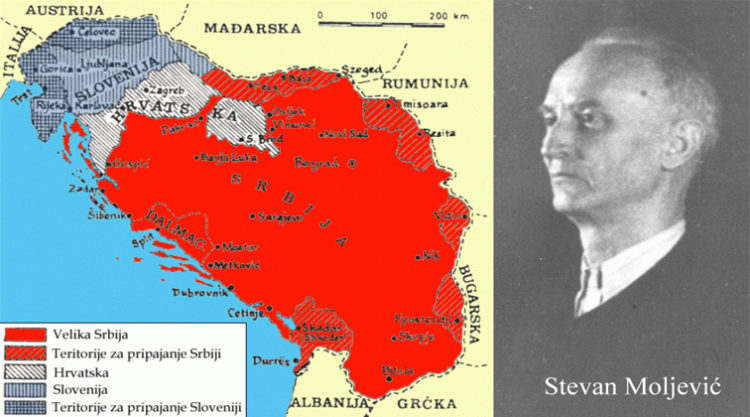HOMOGENA SRBIJA – plan istrebljenja Bošnjaka i Hrvata
„Homogena Srbija“ je memorandum banjalučkog advokata Stevana Moljevića objavljen 30. juna 1941. godine, koji postaje progamsko načelo četničkog pokreta

historija.info
Serbia's Secret War: The Chetnik-German Collaborations
8. Genocid i drugi oblici zločini četnika Draže Mihailovića
Četnici Draže Mihailovića su, po njegovim naređenjima i direktivama, u toku čitavog rata i okupacije izvršili brojne zločine nad narodima u svim krajevima Jugoslavije, uključujući i genocid nad Bošnjacima. Tako su, pored ostalog:
- u novembru 1941. u selu Brajićima na mjestu zvanom Drenovi Vrh četnici su strijeljali oko 500 zarobljenih partizana i njihovih pristalica;
- početkom novembra 1941. Mihailovićev komandant Ajdačić zaklao je trinaest partizanskih simpatizera u blizini Kosjerića na mjestu zvanom Ridovi, među kojima i učiteljicu Jelenu Subić-Gmizović i Milevu Kosovac, koje su četnici prije nego što su ih zaklali silovali i unakazili usijanim gvožđem;
- 4. novembra 1941. četnici su blizu Ravne Gore ubili oko 30 partizana, koje su na prevaru zarobili, među kojima je bilo 18 djevojaka koje su bile upućene u Užice za bolničarke;
- u decembru 1941. Mihailovićevi četnici strijeljali su zajedno sa Njemcima u Čačku samo u jedan mah 80 pripadnika Narodnooslobodilačkog pokreta;
- u decembru 1941. u srezu požeškom mješoviti njemačko-četnički sud u jedan mah osudio je na smrt 12 pristalica partizana;
- u jesen 1941. četnici su poklali oko 1.100 Bošnjaka u Kulen-Vakufu (te četničke jedinice su u to vrijeme bile na strani ustanika u Bosni i Hercegovini);
- u periodu od avgusta 1941. do kraja januara 1942. četnici su u jugoistočnoj Bosni ubili oko 8.000 Bošnjaka. Najmasovnija klanja su vršena na mostovima na Drini u Foči i Goraždu;
- Četnici su na Boričkoj visoravni 18. decembara 1941, samo u jednom danu zaklali oko 1.080 civila, od čega je utvrđen identitet, pol i starosna dob, uglavnom, za 930 žrtava: 524 djece, 223 žene (uglavno majke ubijene djece) i 183 muškarca;
- u toku decembra 1941. i tokom cijele 1942. Mihailovićevi “leglizovani” četnici pohapsili su i predali Njemcima u raznim krajevima Srbije hiljade pristalica partizana koje su Njemci strijeljali u logirima na Banjici, Nišu, Užicu, Čačku i drugim mjestima. Pored toga, četnici su poubijali na hiljade pristalica partizana, opljačkali mnoga sela, batinali hiljade ljudi, a veliki broj žena i djevojaka iz partizanskih porodica silovali;
- prvog aprila 1942. četnici Rade Radića pobili su u Jošavki 20 ranjenih partizana, među njima i teško ranjenog narodnog heroja dr Mladena Stojanovića;
- aprila 1942. četnici Lazara Tešanovića i Rade Radića (koji su se tada bili stavili pod komandu Mihailovićevog kapetana Račića) ubili su 70 ranjenih partizana;
- krajem aprila 1942. Spasoje Dakić, komandant Mihailovićevog bataljona u Čelebiću, ubio je engleskog majora Terensa Atertona i njegovog radio-telegrafistu, kao i jednog engleskog narednika;
- juna 1942. Mihailovićevi četnici su u okolini Gacka (u selu Izgorima) zapalili bolnicu sa deset teških partizanskih ranjenika;

hr.wikipedia.org


